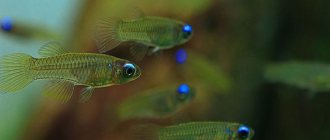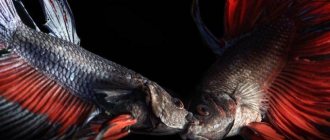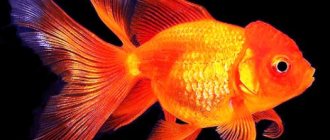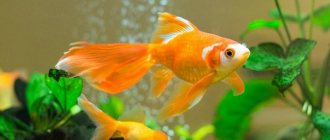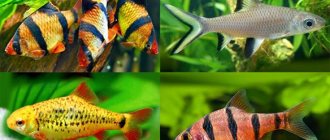A cute inhabitant of the warm waters of South Asia, the Lalius immediately attracted the attention of aquarists and quickly gained popularity.
This unpretentious fish does not require large volumes of water, behaves peacefully and has a bright appearance.
How to care for your lalius, who can you share it with, and how to protect your striped beauty from disease?
Habitat in nature
The first reports of the discovery of a new species of river inhabitants appeared in the 30s of the 19th century. Bright flocks of lalius were spotted in the waters of South Asia, in India, Pakistan and Bangladesh.
Assumptions that they can be found in similar climatic conditions of Myanmar and Nepal have not been confirmed.
The fish began to be exported to other countries, and today they successfully live in small rivers and streams of Singapore, Colombia, and the southern regions of the United States .
Lyalius prefer shallow reservoirs with abundant vegetation. Initially, the new breed of fish was called Colisa lalia, but in the modern classification it was renamed Trichogaster lalius.
Natural habitat
In nature, you can find apistograms in the rivers of South America. The reservoir should have a low current speed, a bottom covered with sand and an abundance of algae .
The fish spend most of their time near the shore, where there is shallow depth and it is easy to protect themselves from enemies.
A small family of fish occupies its own territory and carefully guards it from uninvited guests.
The owners may even show aggression when encroaching on their piece of the coastal zone, quickly attacking the fish that swim there.
The same behavior persists in aquarium conditions, especially with a small volume of water.
The fish are thermophilic and can easily tolerate water temperatures of 30 °C almost all year round. In the natural environment, Apistogramma feed on small insects, plankton and detritus.
Description
The photo of the fish shows that its body is compressed on the sides and beautifully framed by rounded fins running along its entire length.
Directly under the gills there are thin threads called fins, which serve to palpate surrounding objects.
The length of males is 7–7.5 cm, females are smaller, about 6 cm. The color of most species is striped, consisting of two or three colors. Males are brighter than females. The lifespan of fish is 4 years .
Varieties
Approximately the same in size and conditions of detention, the types of lalius are divided according to their color characteristics. We present popular types, descriptions and photos.
Neon
Lalius neon is a typical representative of the species with an unexpected coloration for the name: its body shines with a red flame , for which the fish is mistakenly called Lalius red.
The real red lalius is completely colored in the prevailing color, while in the neon species the red tone is originally diluted with a blue dorsal fin and bluish scales on the gills.
Peaceful in nature, neon loves dense greenery where it hides from trouble.
Rainbow
Along the body of the rainbow lalius are transverse stripes of blue and red. They are located diagonally so that towards the back they almost merge into a red tone, and along the bottom of the abdomen they become completely blue.
Interesting! When the lighting changes, the red color turns orange, and the delicate blue transforms into a deep blue.
Cobalt
The cobalt species is the result of long selection. The fish has a pronounced blue color with almost imperceptible stripes . This lalius is slightly smaller in size than other species; its body length does not exceed 6 cm.
Lalius blue is similar to the cobalt variety, but its body color is more delicate and not so bright. Rarely found on sale.
Yellow nano
A small fish (up to 4 cm) with a juicy yellow body color. Looks impressive when kept in nano-aquariums. Easy to care for and has a friendly disposition.
Coral
It is enough to look at the coral variety of fish to be convinced that the lalius is striped. This species has many stripes, which are colored in both red-orange and yellow-blue shades .
They run throughout the body from the back to the abdomen, forming a bizarre pattern. And its fins are also striped with bluish dots.
Blue dwarf
The blue base of the fish's body is brightly colored with red and blue-green transverse stripes. A spectacular addition to the main color is the red edging of the caudal and dorsal fins.
The dwarf lalius is similar in appearance to the gourami, but unlike the latter, its scales are completely blue and not spotted .
Appearance
All types of apistograms have common external characteristics.
- The aquarium fish has a transversely flattened and slightly elongated body. The head is pointed, the eyes are large.
- Sizes, depending on the species, vary in the range of 3–12 cm. Males are brighter and larger than their female relatives.
- The fin on the back is large and consists of 15–20 pointed rays. The pectoral fins are small, round in shape, the anal fin is elongated and formed by 3–6 rays.
- The scales are well defined. The degree of expression of the lateral stripe depends on the species: from wide over the entire length of the body to barely noticeable only near the gills.
- Life expectancy in good conditions is up to 5 years.
- The color can combine almost any color of the rainbow: yellow, red, blue, green. Some hybrid species have neon colors. Most often, the fins are colored in contrast to the body.
Interesting! The brightness of the color depends not only on gender and health, but even on mood. During the mating season it is most pronounced, and, for example, during transplantation it turns pale.
Difficulties of content
Keeping and caring for lalius requires experience and patience. Fish are shy by nature, do not display good health, and are susceptible to stress. The aquarium should be installed in a place where they will be calm and quiet.
Any loud sounds can frighten the Lalius ; they will experience constant nervous tension, which will significantly shorten their lifespan.
Despite their small size, one pair of laliuses requires a tank with a minimum volume of 40 liters. The main parameters look like this:
- water temperature - 22...27 °C;
- acidity - 6.5–7 pH;
- hardness - 5–20 dH.
The aquarium should be equipped with a good filter, but without a strong current. There is no special need for an aerator, since Lalius belong to the labyrinthine family and can take air directly from the atmosphere .
Important! Do not plant floating plant species in an aquarium with lalius so that they do not cover the surface of the reservoir and the fish can freely take in air.
For the comfort of your pets, it is necessary to plant one of the corners of the aquarium with dense underwater plants. As a substrate , you should take river sand or dark-colored pebbles - against such a background, the color of the fish will look brighter.
REST
Arowana
It’s worth saying right away that the fish is one of the most expensive, which is why it is considered rare. It can grow up to 50 centimeters or more in an aquarium with a volume of 400-500 liters. This is an oblong silvery fish that stays mainly at the surface of the water.
Macrognathus
The snake-like fish, which constantly stays at the bottom, hides in snags and plants. As a rule, it grows to 10-15 centimeters. If there are small fish in the aquarium, he can eat them all when he goes out hunting at night.
Rainbows
The size of the fish varies, but in general they do not grow more than 8-10 centimeters. There are also smaller species. All fish are beautiful, silver in color, with different shades. The fish are schooling and live calmer in a group.
Tetradon dwarf
A miniature version of its larger sea counterparts. It grows no more than 2 centimeters long. Unfortunately, the fish does not live very well, if something does not suit it, it is very whimsical to the conditions. If there are small snails in the aquarium, he will definitely eat them all.
Feeding
In the wild, laliuses feed on insect larvae and plankton. They also obtain food by knocking down insects with a stream of water released from their mouth. They dilute protein foods with succulent plant leaves.
for domestic laliuses , which can be purchased at any pet store .
They are fully balanced in microelements and have a fine fraction, which is important for fish with a small mouth opening.
Feed the Lalius once a day and do not forget about fasting days.
Interesting! Do you want your pets' color to be brighter? Introduce Tetra Rubin cereal into their diet.
Compatibility and Behavior
Lalius have good compatibility with the same peaceful and inactive fish species. The following would suit them as quiet neighbors:
- gourami;
- angelfish;
- labeo;
- iris.
Scandalous cichlids, barbs and other types of predators are not suitable for living together with laliuses . The inevitable fights in such a situation will lead to the death of more peaceful pets.
If you keep a species aquarium in which only laliuses live, select their number so that there are always more females than males . In addition, for females you need to install shelters and plant dense plants.
Reproduction and breeding
Readiness to produce offspring occurs at 7 months. The fact that the pair has formed can be seen from the behavior of the male: he is actively engaged in building a nest and chasing the female.
For successful spawning, the pair must be transferred to a separate container . Parameters for the spawner:
- volume - 20–30 liters;
- water column height - 10–15 cm;
- water temperature - 26...28 °C;
- hardness - no more than 4–6 dH.
The spawning tank is equipped with round-the-clock lighting. A few floating plants (riccia or duckweed) are placed on the surface of the water - the male will need them to build a nest.
Spawning lasts up to 6 hours, during which the female can spawn up to 600 eggs . During the spawning process, the male fertilizes the eggs.
After the female “gives up” all the eggs, they are removed. The male is in charge of the nest. After 3-4 days it should also be removed from the spawning tank, otherwise it will eat the fry.
The fry are fed with special dry food or chopped live food.
Diseases
Blue tangs get sick easily. With timely treatment, they recover safely. A common disease is cryptokaryon.
Cryptokaryon is caused by parasites present in seawater. Wild-caught fish are highly likely to be contaminated. The disease manifests itself due to the stress of moving and weakened immunity. Symptoms: the appearance of white growths 0.5–1 mm in diameter. As the disease progresses - up to 2 mm.
For treatment, place the sick blue pet away. Pet stores sell copper-containing preparations (copper sulfate). Dilute according to the attached instructions. Treatment lasts 2–4 weeks. Procedures in a community aquarium are not possible due to the presence of corals that cannot tolerate copper.
To prevent the disease, regular water changes and UV irradiation of the main jar or sump are recommended.




